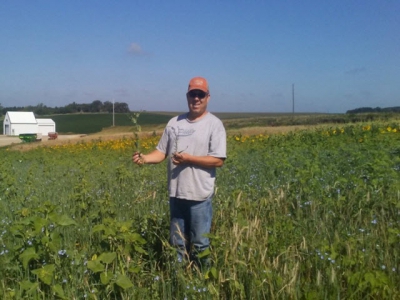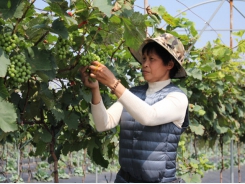40 seasons - Farming in a new direction

Production resilence and better quality of life come from no-till plant diversity and livestock grazing.
Ten years ago, Scott and Pam Heinemann began changing the direction of their farming operation near Winside, Nebraska. Tilling, growing corn, and feeding cattle had shaped the path of the farm since the days of Scott Heinemann’s grandfather.
Experimenting with no-till was the Heinemanns’ first detour.
“Because it eliminates tillage operations, we initially saw no-till as a time-saver,” he says. “We weren’t farming enough acres to be able to afford hiring full-time help.”
Always interested in exploring possible opportunities in new practices, the Heinemanns soon took more steps in a new direction. They diversified the crop rotation, added cover crops, stopped buying cattle to feed in the on-farm feedlot, and instead began renting cover crops to area cow/calf producers for grazing.
“There was definitely a transition period when the changes weren’t necessarily paying off,” says Heinemann. “It was particularly hard because the transition was occurring at the same time that corn and soybean prices were high.”
Still, he had read about the experiences of North Dakota no-till farmer and cover crop grower Gabe Brown. “That article opened my eyes and helped me turn a corner.”
FINANCIAL RESILIENCY
Today, their farming course is indeed off the beaten path. It’s also financially resilient.
“Our profitability is certainly more secure than it was 10 years ago,” he says. “Since adding diverse crops and livestock grazing, we’ve ramped up the soil biology. While yields have held steady, we’ve realized significant savings in fertilizer applications. We apply nitrogen only to corn and only at about half the rate we were applying five or six years ago.”
As cash crops, the Heinemanns grow corn, soybeans, oats, and cereal rye for seed. The cereal rye in particular offers soil-building benefits.
“Our rye grows 5 feet to 6 feet tall in the spring after it’s fall planted,” he says. “The rye protects the soil from wind and water erosion, and the roots do wonders with compaction because they penetrate deep into the soil. And the rye retains moisture. It’s surprising how much moisture is in the soil after we harvest the rye.”
Following the harvesting of the oats and rye crops in mid- to late July, Heinemann no-till plants a cover crop comprising 10 to 12 species, including grasses, broadleaves, brassicas, and legumes.
Typically, late-summer and early-fall rains get the cover crop off to a good start and ready to graze by late September. Several area cattle producers have worked with the Heinemanns in the six years since they started offering cover crops for grazing.
Because the practice of renting cover crops for grazing was new in their community when they started six years ago, they initially offered the grazing opportunity at no charge. Now that they have developed some watering spots and constructed the four-strand barbed-wire perimeter fence and interior crossfencing of a single-strand electric wire, they charge a grazing fee of $1 to $1.75 per head per day.
The livestock Heinemann prefers to graze are cows whose calves have been weaned early. “Calves can be hard to hold inside the fence,” he says.
Crossfencing for five paddocks per 40-acre field provides the controlled grazing needed to keep livestock from taking too much plant material. He describes his experience with grazing like this: “I don’t want the cattle to take more than 50% of the above-ground material. When you remove more than 50% of the above-ground forage, roots slow down and even stop growing.”
He aims ideally for cattle to graze only the top third of the cover crop biomass. “By taking just that much above-ground growth, the grazing seems to stimulate root growth,” he says. “The plants recover quickly and keep growing.
“Adding livestock to the system has been an important way for us to kick-start the soil biology,” says Heinemann. “We’ve been fall and winter grazing for six years on the land that we own, and we’re really starting to see the results in improved soil biology. We see many earthworms, and the texture of the soil is improving.”
OTHER PLANTINGS
To further conserve soil and create buffer zones in areas where water runs off fields, the Heinemanns have established native grasses in water runways and low-bottom field edges. They’ve also planted “hundreds” of trees and added shrubs to the plantings. The Lower Elkhorn Natural Resources District cost-shared the planting. The areas provide habitat for quail and pheasants.
“We also planted a mix of wildflowers in those areas,” he says “and Pheasants Forever provided the seed.”
Wildflowers grow, too, in the 40-feet-wide pollinator edge the Heinemanns developed around one quarter section of land. The flowers grow amid the native grasses they established in the strips. The pollinator field border is supported by programs offered by the USDA Natural Resources Conservation Service.
Always looking for ways to add plant diversity to the cropping system, Heinemann is experimenting with an eight-species cover crop planted directly into the corn crop in June. Using an old John Deere no-till planter, he was able to plant two rows of cover crop in between 40-inch corn rows.
“The corn and the cover crops are growing like companion crops, and the corn looks beautiful,” Heinemann said in late August of the planting year.
“I’m always looking for ways to get away from crop monocultures,” he says. “Adding plant diversity is the biggest change we’ve made to our operation in the last 10 years.”
KEYS TO NO-TILL SUCCESS
Properly adjusted planter. Properly adjusting seeding depth on no-till planters is critical to proper seed placement, says Nebraska no-tiller Scott Heinemann. “And make sure seed openers are in good shape,” he says. “You just can’t spend enough time on the planter. Failures with no-till typically come back to the planter.”
Uniform residue management. “No-till starts with the combine,” says Heinemann. Spreading the residue uniformly across the width of the header cut creates uniform planting conditions for spring seeding. If residue is thin in some areas and thick in others, the seed may be planted too deep in the thin-residue areas and too shallow in areas where residue is thick.
A mind-set for success. “When we’re trying something new, it seems it’s our human nature to not want it to work because it’s different from the way we’ve always done things,” says Heinemann. “So when you’re trying something new, make sure you do everything you can to help it succeed.”
Có thể bạn quan tâm
Phần mềm

Phối trộn thức ăn chăn nuôi

Pha dung dịch thủy canh

Định mức cho tôm ăn

Phối trộn phân bón NPK

Xác định tỷ lệ tôm sống

Chuyển đổi đơn vị phân bón

Xác định công suất sục khí

Chuyển đổi đơn vị tôm

Tính diện tích nhà kính

Tính thể tích ao hồ




 Vietnamese agricultural products record impressive exports
Vietnamese agricultural products record impressive exports  Reaping 'sweet fruits' from growing organic vegetables
Reaping 'sweet fruits' from growing organic vegetables